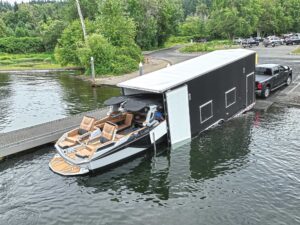As personal-watercraft enthusiasts demand more and more from their rides, manufacturers increasingly rely on sophisticated technologies to boost performance, improve durability and lavish boaters with more creature comforts. It’s a high-tech revolution — and proof positive that builders have moved their thinking well outside the traditional fiberglass box. The flagship craft on the following pages sport computer brains, space-age hull materials and new-age performance tweaks. And yet, they haven’t forgotten what is by far the most important element: fun. In fact, the tech-driven makeovers allow these machines to tour, tow or just beat a buddy across the lake a little better than ever.
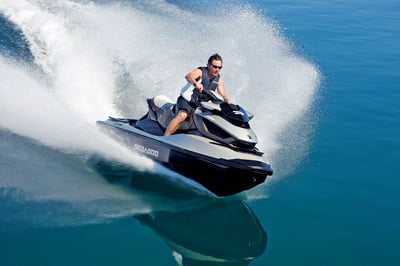
Sea-Doo GTX Limited iS
Sea-Doo has brought true independent suspension to the PWC market. They did it by separating the hull and passenger area into two separate components. Barrel through the chop, and your spine won’t suffer the consequences. Instead, the seat, handlebars and even the footwells move within the hull (as much as 6 inches) to absorb much of the shock. Aluminum arms, fore and aft, control the travel. A center-mounted spring and shock absorber provide the cushion. Hydraulics automatically adjust to load and water conditions. Switch to manual and you can control the level of cushioning, opting for a firmer ride for performance or a cushier one for cruising.
That’s cool enough, but it’s the brakes, and what the technology enables, that truly stand out. By mating the reverse bucket to the craft’s computer brain, Sea-Doo has enabled the iS to dramatically arrest its forward motion. Squeeze the brake lever and the computer briefly reduces water flow to the pump, allowing the bucket to drop into position. A split second later the thrust resumes, with the computer gauging the amount of water to deliver based on the craft’s speed and how firmly the driver is squeezing the handle. The result is a controlled stop in about half the distance normally required.
The same system also allows the iS to do the most unlikely of PWC maneuvers — start in neutral. Hit the start button and the craft comes to life and holds a stationary position, thanks to a partial deployment of the reverse bucket. Squeeze the throttle and you move into forward. Apply reverse and you’ll back away in control. It’s a completely intuitive solution that will change the way a PWC handles around a tight launch ramp or marina.
Bonus Tip: Going on a longer cruising ride? Don a wetsuit or a pair of neoprene shorts instead of a swimsuit or boardshorts. The tight fit will prevent chafing and prove far more comfortable.
Hot Buttons
• Smart tilt: Many tilt steering systems cover the gauge array. Sea-Doo wisely links the instrument cluster to the handlebars, allowing them to pivot in unison.
• Versatile Speed Control: Drive-by-wire throttle, linked to a GPS speedometer, allows for both a no-wake mode and cruise control.
• Performance: GPS-based speedometer will limit speeds in excess of 65 mph; expect 0-30 acceleration in less than two seconds.
Numerically Speaking
* Length: 139.2″
* Beam: 48.19″
* Dry Weight: 948 lb.
* Engine: 1494CC, Supercharged/Intercooled 4-cylinder, 4-stroke
* Fuel Capacity: 18.6 gal.
* Storage Capacity: 16.4 gal.
* MSRP: $16,499
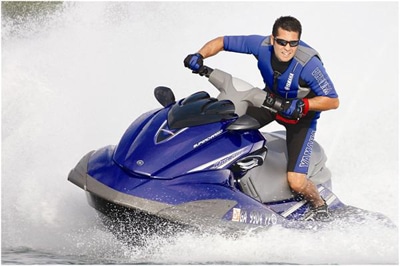
Yamaha(FZR)
Yamaha loves research. And when the company decided to focus on a new, performance-oriented two-seater for 2009, that research revealed some interesting facts about its more-aggressive customers’ riding styles. First, a whopping 81 percent of them often stand on their so-called sit-down models. And second, they do so more than a quarter of their time on the craft. The catch? A typical runabout’s handlebar position remains in a fixed, seat-friendly position. Yamaha chose to address this problem on the new FZR with a unique solution — a telescoping handlebar column.
Choose to stand, and rather than hunch like Lance Armstrong in a time trial, the handlebars rise up to you, as much as 100 mm above their base setting. The position provides a more-comfortable riding stance atop the craft when standing to absorb rough water and provides a certain degree of leverage when simply play riding. Drop to the middle position, and the handlebars rise to the typical height you might expect from a watercraft. Choose the lowest setting, and the craft suddenly feels like a Superbike, able to be carved aggressively on calm waters.
In the spirit of the brand’s past performance two-ups, Yamaha gave the FZR, and its three-passenger sister ship the FZS, a more-aggressive hull than the mainstream FX series. The running surface is decidedly shorter, and full-length lifting strakes improve top speed. A dihedral keel shape is reminiscent of the former GP series and aimed at enhancing the craft’s cornering abilities. A large pump inlet gives the craft a better bite on the water to enhance acceleration. It’s the chine shape, however, that gives the craft its ultimate handling appeal. Chines softly angle inward, giving the craft a fun, lean-in riding style.
Bonus Tip: You no longer need to lean to the outside of a turn to keep a PWC hooked up. Cut racelike corners by using a little inside lean, shifting your inside leg forward and putting your outside foot aft.
Hot Buttons
• Nano Nano: Nanotechnology hull material reduces weight, increasing acceleration and top speed.
• Remote Transmitter: Engages security system and activates low-speed mode for beginners.
• Telescopic Handlebar: Raise or lower the handlebar for comfort.
• Cheap Gas: All Yamaha engines are optimized to run on 87-octane fuel.
• Performance: Expect 65-plus mph top speed rocket hole shots.
Numerically Speaking
* Length: 132.7″
* Beam: 48.4″
* Dry Weight: 807 lb.
* Engine: 1812CC, Supercharged/Intercooled 4-cylinder, 4-stroke
* Fuel Capacity: 18.5 gal.
* Storage Capacity: 21.3 gal.
* MSRP: $12,599
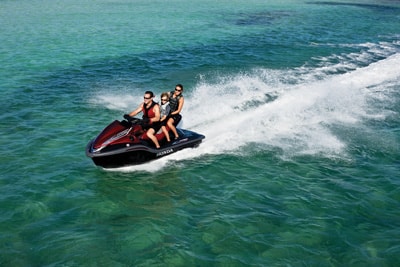
Honda(Aquatrax F-15X)
After not producing a truly new craft since 2003, many view Honda’s introduction of the F-15X as confirmation of how much the company values its AquaTrax brand. And while the colors and graphics might still err on the side of understatement, the 15X hull design is dramatic. Consider the bow: It’s wide and aggressive, giving the craft an instantly distinguishable look. Then let your eyes follow the bond line. Raised at the bow and sweeping dramatically as it travels aft, it artfully blends form and function. The form is obvious; the function is revealed on the water. That raised line helps knock down spray and results in one of the driest rides on the water. It also protects the boat at the dock. Where most PWC slip below the average dock beam, inviting scratches and dings, the Honda’s beefy rub rail protects the craft.
On the water the machine feels solid, wide and utterly predictable. The 15X is longer, wider and heavier than the previous Honda F-12, a combination that gives it a stable presence both underway and at rest, and makes it a good choice for the family cruiser. The 1470cc, turbocharged engine below, however, is ready to run with the big boys. Sixty-five mph has become the de facto standard for the market’s flagships, and despite a 197 hp rating, the 15X achieves its goal. More importantly, it avoids the dreaded turbo lag that plagued previous Honda models. Honda has placed both the turbocharger and intercooler closer to the throttle body, and boost pressure now kicks in as low as 2,500 rpm. Combined with an intake grate that more effectively loads the top of the pump and a reduced diameter of the jet nozzle, the result is the nearly instantaneous throttle response enthusiasts demand.
Bonus Tip: On any PWC, passengers often feel less than secure. Try holding onto an aggressive driver’s PFD straps rather than a seat strap or grab handle. Where they go, you’ll follow.
Hot Buttons
• Countdown Fuel Display: Fuel-consumption display details the remaining riding time based on current speed and fuel.
• Instrument-Based Security: Program your keyless ignition with up to 999 PIN options.
• Access Panels: Removable side panels make service access easy.
• Performance: Expect top speed around 64 mph and a 0-30 acceleration time in a little more than two seconds.
Numerically Speaking
* Length: 133.8″
* Beam: 49″
* Dry Weight: 933 lb.
* Engine: 1470CC, Turbocharged/Intercooled 4-cylinder, 4-stroke
* Fuel Capacity: 18.5 gal.
* Storage Capacity: 23.1 gal.
* MSRP: $13,999
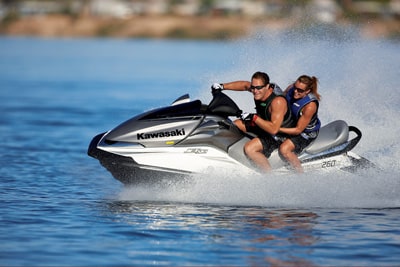
Kawasaki(Ultra 260 LX)
The horsepower wars have returned to the PWC market in recent years, and Kawasaki has responded by bringing out the biggest guns. After Sea-Doo briefly eclipsed the brand in 2008, the Big Green has responded by once again bumping up the horsepower of its flagship Ultra. The tweaks themselves are rather subtle. New pistons have raised the compression ratio. Intake and exhaust camshafts have been redesigned, and the ignition timing has been altered in kind. Kawasaki also owns up to a little fine-tuning of the impeller and stiffening of the hull. The end result, however, speaks for itself. At a realistic 260 hp, the supercharged, 1498cc engine once again makes the Ultra the undisputed horsepower king.
To make the Ultra more than just a winning dragster, Kawasaki added a touring seat with a bolstered saddle that cradles both driver and passengers, with additional back support for long-distance rides. The seat is also tiered, giving the passengers a raised perch to look over the driver’s shoulder. Rounding out the LX upgrades is what can only be called a more mature, sophisticated color scheme. Rather than the standard Ultra’s bold hues, the LX opts for a rich silver metallic.
What hasn’t changed is equally important. The Ultra has always traded a certain degree of cornering ability for its supremely confident ride on the straightaway, a boon in rough waters. That makes it ideal in big lakes and coastal areas. Hull design also provides an extremely dry ride thanks in part to the well-designed spray rail around the bow. The watercraft’s chart-topping capacities also make it excellent for touring: 53 gallons of stowage and a 20.6-gallon fuel tank blow away the class averages.
Bonus Tip: PWC are difficult to secure at the dock. To best avoid dings, center your craft beside a cleat, running a line from the bow or handlebars to the cleat, and then back to the aft grab handle.
Hot Buttons
• SLO Mode: Second magnetic key activates a speed-limiting mode for less-experienced riders.
• Stand or Sit: Five-position adjustable handlebars allow riders to dial in their most comfortable setting.
• Lean-In Style: Deep-V hull banks into turns, allowing riders to employ a natural lean-in, motorcyclelike riding style.
• Performance: Expect a true 65-plus mph top speed and 0-30 acceleration in less than two seconds.
Numerically Speaking
* Length: 132.7″
* Beam: 47″
* Dry Weight: 1062.8 lb.
* Engine: 1498CC, Supercharged/Intercooled 4-cylinder, 4-stroke
* Fuel Capacity: 20.6 gal.
* Storage Capacity: 53 gal.
* MSRP: $12,299

